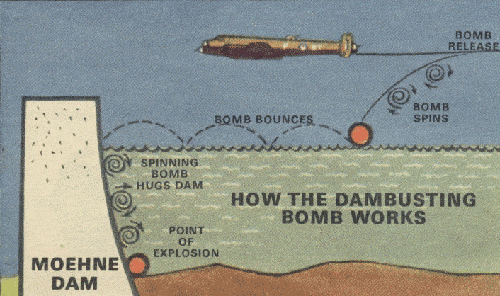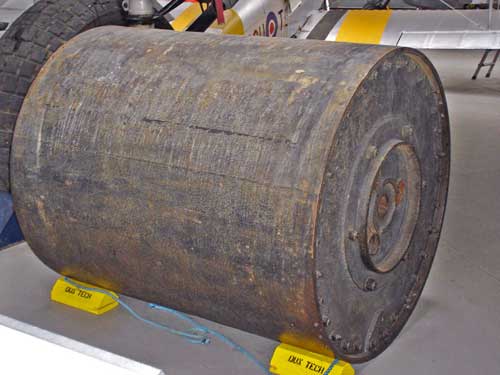The Dambusters - Story of the bouncing bombs (Highballs and Upkeeps)
The bouncing bombs are those cylindrical bombs designed by the British during the Second World War to destroy enemy dams and ships. In these few lines, you will find an historical description of this original weapon, but also pictures and videos showing bouncing bombs drops.
The purpose of the bouncing bomb
The dam targets were largely immune to conventional attack because of their size. An immense amount of explosive would be required to breach them, and the cushioning effect of the water meant that a near miss would be ineffective. However a bomb placed right by the dam would be effective because the water would act as a natural tamping medium, directing the explosion onto the dam, instead of protecting it, and greatly reducing the explosive power required.
At the beginning of World War II, techniques would not allow the placing of a large bomb with the required accuracy. Moreover, the Germans had guarded against attack by torpedo by placing heavy nets upstream of the dams.

The bouncing bomb was designed in 1941 during World War II, by Barnes Wallis in order to destroy enemy dams, but also battleships. The bomb is dropped from a specially modified aircraft over water, bounced over the water (avoiding the torpedo nets) until it reaches the target, and sink and explode under water next to the target, causing heavy damages.
Your browser doesn't support HTML5 video.
The bomb characteristics
Cylindrical in shape, the bouncing bomb, also known as Highball or Upkeep, measured 60 inches (1,5 meter) long and 50 inches (1,3 meter) in diameter. It contained 3 hydrostatic pistols, which measured the hydrostatic pressure of the water as the bomb sank, until it was equal to the pressure corresponding to 30 feet (10 meters) depth. The bomb was also fitted with a 90 second time fuse so that if the hydrostatic mechanism failed, the bomb would still detonate. The bomb weighed a total 9250 lb (4200 kg), 6000 lb (2700 kg) of this weight being explosive charge of TNT and RDX and possibly other materials to improve the efficiency of the explosion.

Your browser doesn't support HTML5 video.

